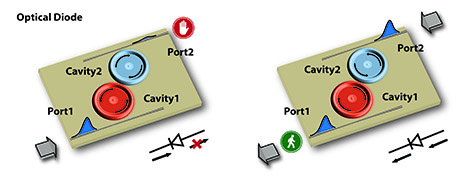A New, Revolutionary Optical Device Could Build Faster And Cooler Computers
Engineers from Washington University in St. Louis have developed an optical diode by coupling tiny doughnut-shaped optical resonators on a silicon chip, that may be used in future computers to make them run faster and stay cooler. The new optical device is being developed by Lan Yang, PhD, associate professor of electrical and systems engineering, and her collaborators, based on the 'Whispering Gallery' phenomenon, which makes a whisper audible from the other side of the dome because of the way sound waves travel around the curved surface.
The research team has made the diode capable of blocking light transmission in one direction and increased it in the other. By coupling the loss and gain devices using PT (parity-time)-symmetry, they had the loss of energy exactly equal the gain at an equilibrium point, where a “phase transition†occurs. Not known to conventional physics, this system triggers different set of behaviors in optical devices. Using two micro-resonators positioned so that light can flow from one to the other, the groundbreaking new optical new device was developed.

One device is the 'lossy' silica resonator, whereas the other incorporates the chemical element erbium into the silica structure for gain. The erbium interacts with light of wavelength 1450 nm and emits photons in the wavelength 1550 nm. A transmission detector set for 1550 nm will see a gain from this erbium-containing resonator. Finally, the PT symmetry is broken and light is able to move in only one direction.
These resonators are really tiny and therefore can be used in modern computers. Currently, the optical diodes are made out of silica, but in future they might be created using other CMOS compatible materials. In their paper published in Nature Physics journal, the researchers have showcased how the mathematical physics concept can be used to provide solutions to practical problems. Moving forward, the engineering researchers believe that their PT concept can find really useful applications in electronics, acoustics and photonic devices with advanced functionalities. The possibilities are endless and we are just a step closer to achieving them.
Source: #-Link-Snipped-#
The research team has made the diode capable of blocking light transmission in one direction and increased it in the other. By coupling the loss and gain devices using PT (parity-time)-symmetry, they had the loss of energy exactly equal the gain at an equilibrium point, where a “phase transition†occurs. Not known to conventional physics, this system triggers different set of behaviors in optical devices. Using two micro-resonators positioned so that light can flow from one to the other, the groundbreaking new optical new device was developed.

One device is the 'lossy' silica resonator, whereas the other incorporates the chemical element erbium into the silica structure for gain. The erbium interacts with light of wavelength 1450 nm and emits photons in the wavelength 1550 nm. A transmission detector set for 1550 nm will see a gain from this erbium-containing resonator. Finally, the PT symmetry is broken and light is able to move in only one direction.
These resonators are really tiny and therefore can be used in modern computers. Currently, the optical diodes are made out of silica, but in future they might be created using other CMOS compatible materials. In their paper published in Nature Physics journal, the researchers have showcased how the mathematical physics concept can be used to provide solutions to practical problems. Moving forward, the engineering researchers believe that their PT concept can find really useful applications in electronics, acoustics and photonic devices with advanced functionalities. The possibilities are endless and we are just a step closer to achieving them.
Source: #-Link-Snipped-#
Replies
You are reading an archived discussion.
Related Posts
Lava Mobiles has today launched a new smartphone called the Lava Iris Pro 20 in India. As we take a look down the phone's specifications list, we find a 4.5-inch...
LogmeOnce fulfills an everyday need. Who isn’t worried these days about getting hacked, forgetting their passwords, or just being vulnerable because they have weak passwords? LogmeOnce offers a secure, easy-to-use...
Linda Garmon submitted a new project:
ScratchJr - We are developing a computer coding language for children ages 6 to 7!
Coding is the new literacy. That's why we are...
Japanese smartphone maker Sharp has announced a new flagship smartphone for their Aquos line-up. The company has named this phone - Aqous Xx302Sh. The most peculiar thing about this smartphone...
Last year, Sony entered the mirrorless camera market by launching A7 and A7R and now it looks like the company wants to establish itself in this market. The Japanese company...
